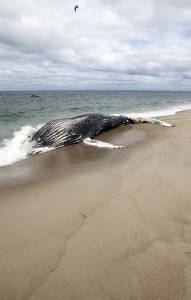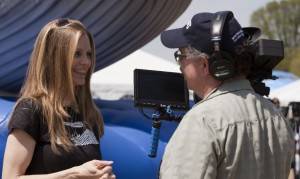5D and a Whale of a Time

The juvenile humpback was tethered to two trucks further up the beach to insure that it wouldn't wash away in the night.
A dead juvenile humpback whale had been spotted floating off of Stellwagen Bank on Thursday. By Saturday, it had drifted with the tides down to Chatham and lodged on a sandbar a quarter mile from Chatham Light Beach. The MMRR team, who had been tracking the whale, were called into action and the Chatham Harbor Master towed the the animal up onto the beach where the team would have easy access to it.
As any event like this is always a spectacle, the MMRR team wanted someone there to help them manage any media that might show up. A small documentary crew was already there. They were working on a show for the Discovery Channel about the Great White Shark population that have been inhabiting the waters around Chatham for the past few seasons. Weather kept them ashore so they hung around and advantageously shot the whale. They had no intent to use the footage. It was just too fascinating not to shoot. Turns out that the shooter was Nick Caloyianis, one of only 2 Nat-Geo cinemaphotographers to have ever survived a shark attack. You can check his story out here. He told it to me while we were hanging out and it’s amazing!
When I got there on Saturday, two members from the MMRR team, CT and Jane, were already on site and had just finished tying up the whale, securing it so it wouldn’t wash away in the hight tied overnight. They would have to wait until Sunday for the heavy equipment to arrive before they could engage in dispatching the animal.
On my way to the site Saturday, I stopped by work and grabbed the 5D Mark II kit as it was ready to go, light and at hand. We had recently received all of the components for the 5D field kit that we needed to do this kind of field production and I was eager to put it through its paces. We’ve had the base 5D kit for some time but had just received the rest of the components to make it usable for this kid of run-and-gun production. The kit includes the 5D with the Canon 24-70mm glass, a Red Rock microShoulder mount with the micoRiser offset, microFollow Focus, the Zacuto Z-finder, and a JuicedLink lined in to a Sennehiser ME66.
On Saturday, I went in light because I didn’t know what the situation was. I configured the camera hand-held with the 5D on the short rods with the follow focus and z-finder only– no shoulder rig or sound set up. It was a hike up the beach to the site so this configuration worked out well. There wasn’t much going on other than securing the whale and answering questions to passers by and it was good not to be encumbered with the full rig.
I had intended to get IFAW’s full EX1 package on my way back home Saturday evening in preparation to shoot the events Sunday, but a situation with the locks on the doors at headquaters prevented me from being able to get in that night. I had plans for all sorts of zooming, moving, fluid coverage. Being locked out, I was stuck with the 5D kit I already had on hand. I was a little freaked by the situation as it’s limiting to shoot with the 5D. But it turned out to be a great opportunity. I had to limit how I covered the event– old school style. No zoom and the various limits of shooting the 5D meant that I had to really think about the coverage and shot/sequence composition. I haven’t had to think that much about how I shot since the last time I shot film, and that was a long, long time ago. It was actually a lot of fun and I am really pleased with the results.
The necropsy process happened first thing Sunday morning. It took a few hors for the team to do all of the necessary documentation and to get the animal further up the beach before any cutting could happened. There was a bevy of extra personal and volunteers, all of them biologists, teachers, retired teaches, or other like minded peoples, and I couldn’t help but notice a certain excitement and gleam in their eyes. They all took to the work like a 5 year old opening presents on Christmas day. Granted, I get it. This kind of event happens once or twice a year at best. And when it comes, it’s exciting– monumental. But to the uninitiated, this is quite a dramatic process. I was good until the knives came out. Once the cutting started in force, I had to take a step back. I think that’s reflected in the video.
The other factor is the smell. Obvious right? It was fine until they punctured the body cavity and “de-gassed” the beast. After that, if you were down-wind and a neophyte, you wanted to go running home to Momma. The Pros didn’t bat a nostril. In fact, I think they liked it.
The video speaks for itself I think. Please have a look and comment as you see fit. This is my first shoot using only the Canon 5D Mark II and I think I’ve proved to myself that it can be used in this sort of ENG situation. As for my shed? It still waits, patiently, for the attention it deserves.
Cheers
–R.
IFAW Whale Necropsy from Rich Moos on Vimeo.
My first all-5D shoot.
5DMK2
Z-Finder
Redrock microShoulderMount Deluxe Bundle w/ offset and follow focus
Juicedlink
Sennhiser ME66
Cut in FCP 7
Graded in Color
More deets at cathartic.com/5d-and-a-whale-of-a-time

